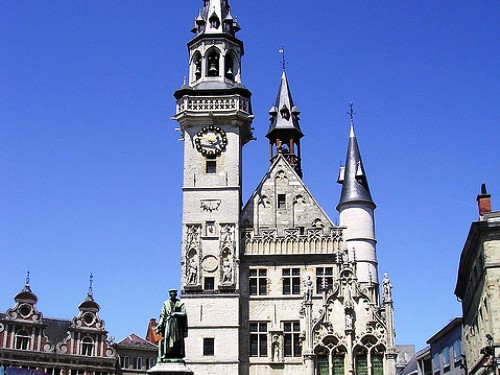Belfries of Belgium and France are a group of 56 historical buildings designated by UNESCO as World Heritage Site, in recognition of an architectural manifestation of emerging civic independence from feudal and religious influences in historic Flanders and neighbouring regions , leading to a degree of local democracy of great significance in the history of humankind.
Besides civic belfries, or buildings such as city halls that rather obviously may have rendered a similar service, the list includes religious buildings that also had served as watchtower or alarm bell tower: the Cathedral of Our Lady in Antwerp and the St. Rumbolds Tower in Mechelen Flanders, and the St. Leonard’s Church in Zoutleeuw (Flemish Brabant).
Built between the 11th and 17th centuries, they showcase the Roman, Gothic, Renaissance and Baroque styles of architecture. They are highly significant tokens of the winning of civil liberties.
While Italian, German and English towns mainly opted to build town halls, in part of north-western Europe, greater emphasis was placed on building belfries. Referring originally to mobile wooden towers used in siege warfare, the term was later applied to the wooden watchtowers mounted on the palisades surrounding the portus or pre-urban centres.
It was to be applied in particular to those housing bells or standing next to the bell tower. Palisades, bells and the right to possess bells are all closely associated with the development of urban life. The 31 belfries in Flanders and Wallonia and the 23 in north-eastern France, invariably found in an urban setting, are imposing bell towers of medieval origin, generally attached to the town hall and occasionally to a church.
In addition to their outstanding artistic value, the belfries are potent symbols of the transition from feudalism to the mercantile urban society that played a vital role in the development of late medieval Europe.
Many of the belfries now in existence are successors to wooden constructions, often destroyed by fire and known only through archives, which give no descriptions. The multi-purpose belfry soon came to be built of stone to prevent the risk of future fires. After several fires, stone began to be used as building material instead of wood.

Mainly square, robust towers were built in this period. Later, from the 14th to the 17th century when most of the still remaining belfries were built, the towers lose their defensive character. They become narrower, and the styles are influenced by Baroque.
There are quite a number of spectacular UNESCO World Heritage Sites to be found in Belgium. With the Carnivals of Binche and Aalst and the Procession of the Holy Blood in Bruges this is the only Northern European country to have several Masterpieces of the Oral and intangible Heritage of Humanity listed.
Belfries are very symbolic of this part of Europe. Whereas in Italy, Great Britain or Germany, large town halls were built as symbols of power and prosperity, in this region a greater emphasis was placed on the building of belfries. Today only a handful of Béguinages still exist, but they continue to form an essential part of the architectural heritage of a number of cities.